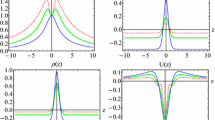Abstract
In contrast with pseudo-gravitational effects that are mathematically analogous but physically quite distinct from gravity, this presentation deals with a kind of quasi-gravitational effect that can act in an asymmetrically moving brane worldsheet in a manner that approximates (and in a crude analysis might be physically indistinguishable from) the effect that would arise from genuine gravitation, of ordinary Newtonian type in nonrelativistic applications and of scalar–tensor (Jordan–Brans–Dicke rather than pure Einstein) type in relativistic applications.
Similar content being viewed by others
REFERENCES
Arkani-Hamed, N., Dimopoulos, S., and Dvali, G. (1999). Phenomenology, astrophysics and cosmology of theories with sub-millemeter dimensions and TeV scale quantum gravity. Physical Review D: Particles and Fields 59, 086004 [hep-ph/9807344]
Battye, R. A. and Carter, B. (2001). Generic junctionconditions and minimal coupling in brane world scenarios. Physics Letters B 509, 331–336 [hep-th/0101061].
Carter, B. (1995).Dynamics of cosmic strings and other brane models. In Formation and Interactions of Topological Defects, R. Brandenberger and A.-C. Davis, eds. Plenum, New York, pp. 303–348.NATO A.S.I. B349, Newton Institute, Cambridge 1994. Preprint hep-th/9611054.
Carter, B. and Uzan, J.-P. (2001). Reflection symmetry breakingscenarios with minimal gauge form coupling in brane world cosmology. Nuclear Physics B 606, 45–58 [gr-qc/0101010].
Carter, B., Uzan, J.-P., Battye, R. A., Mennim, A. (2001). Simulated gravity without true gravity in asymmetric brane-world scenarios. Classical and Quantum Gravity 18, 4871–4896 [gr-qc/0106038]
Dicke, R.H. (1964) Experimental relativity. In Relativity, Groups, and Topology (Les Houches 1963), B. & C. De Witt, ed., Gordon &; Breach, New York, pp. 165–313.
Kehagias, A. and Kiritsis, E.(1999). Mirage cosmology. Journal of High Energy Physics 9911, 022, [hep-th/9910174].
Unruh, W. B. (1995). Dumbholes and the effects of high frequencies on black hole evaporation. Physical Review D: Particles and Fields 51, 2827; Preprint gr-qc/9409008.
Visser, M. (1998). Acoustic black holes: Horizons,ergospheres, and Hawking radiation. Classical and Quantum Gravity 15, 1767; Preprint gr-qc/9712010.
Volovik, G. E. (2001).Superfluid analogies of cosmological phenomena. Physics Reports 351, 195–348 [gr-qc/0005091]
Author information
Authors and Affiliations
Rights and permissions
About this article
Cite this article
Carter, B. Quasi-gravity in Branes. International Journal of Theoretical Physics 41, 2201–2210 (2002). https://doi.org/10.1023/A:1021185110875
Issue Date:
DOI: https://doi.org/10.1023/A:1021185110875




